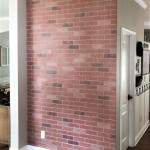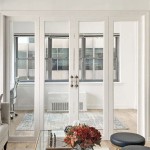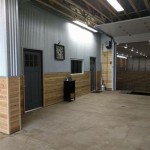1 Room Interior Design Ideas
Designing a single room presents unique challenges and opportunities. Maximizing space, ensuring functionality, and creating a cohesive aesthetic are key considerations. Whether dealing with a studio apartment, a dorm room, or a multi-functional space within a larger home, thoughtful planning is crucial to achieving a comfortable and stylish environment.
Space Optimization
In a single-room setup, effective space optimization is paramount. Furniture selection plays a vital role. Multi-functional pieces, such as sofa beds or ottomans with storage, can significantly increase usable space. Vertical space should also be utilized; tall bookshelves and wall-mounted storage units draw the eye upwards, creating the illusion of a larger room. Strategic placement of mirrors can also enhance the sense of spaciousness by reflecting light and visually expanding the area.
Furthermore, employing clever dividers can create distinct zones within the room without compromising the open feel. Open shelving units, curtains, or even strategically placed plants can effectively delineate areas for sleeping, working, or relaxing. These dividers provide visual separation while maintaining airflow and natural light throughout the room.
Color and Lighting
Color and lighting choices significantly impact the perception of space and ambiance. Light, neutral colors on walls and larger furniture pieces create a sense of airiness and make the room appear larger. Accent colors can be introduced through smaller furniture, textiles, and decorative items, adding personality and visual interest without overwhelming the space. A cohesive color palette, whether monochromatic or complementary, contributes to a harmonious and unified aesthetic.
Lighting plays a crucial role in setting the mood and enhancing functionality. Natural light should be maximized by keeping window treatments minimal and strategically placing mirrors to reflect sunlight. Layered artificial lighting is essential for creating a comfortable and functional environment. Ambient lighting, provided by overhead fixtures or strategically placed lamps, provides overall illumination. Task lighting, such as desk lamps or reading lights, is crucial for specific activities. Accent lighting, directed at artwork or architectural features, adds depth and visual interest.
Style and Functionality
Defining a clear style direction is essential for creating a cohesive and visually appealing space. Whether minimalist, bohemian, or modern, a consistent style throughout the room creates a sense of harmony. This can be achieved by selecting furniture and decor that share similar design elements, materials, and color palettes. Consider the room's primary function and choose a style that complements its purpose.
Functionality is equally important in a single-room design. Furniture should be chosen for its practicality and ability to serve multiple purposes. A comfortable bed that also provides storage, a dining table that doubles as a workspace, and chairs that can be easily moved and rearranged are all excellent examples of functional furniture choices. Storage solutions should be integrated seamlessly into the design, keeping clutter at bay and maximizing usable space.
Integrating personal touches is crucial for creating a space that feels truly lived-in and reflects individual personality. Artwork, photographs, plants, and other decorative items add character and warmth. These personal touches should be carefully curated to avoid overwhelming the space. A few well-chosen items, displayed thoughtfully, can make a significant difference in creating a welcoming and inviting atmosphere.
Textiles, such as rugs, curtains, and throw pillows, offer another opportunity to inject personality and warmth into the space. They can also be used to define zones, add texture, and enhance the overall aesthetic. Choosing textiles that complement the chosen color palette and style direction creates a cohesive and visually appealing environment. The careful selection of materials, patterns, and textures contributes to the room's overall ambiance and comfort.
Maintaining a sense of visual balance is crucial in a single-room design. This can be achieved through symmetrical or asymmetrical arrangements of furniture and decor. Avoiding overcrowding and ensuring adequate space for movement contributes to a comfortable and functional environment. The careful placement of furniture and accessories creates a sense of harmony and visual appeal. Regular decluttering and organization are also essential for maintaining a balanced and harmonious space.
Creating a successful single-room design requires careful planning and consideration of space, functionality, and aesthetics. By implementing these design principles, individuals can transform a single room into a stylish, comfortable, and highly functional living space that meets all their needs.

10 Small One Room Apartments Featuring A Scandinavian Décor

Small 1 Bedroom Apartment Decorating Ideas Decor Bedrooms Interior Design

Interior Design Ideas For Apartments

Amazing One Room Apartments That You Will Have To See Decoratie Klein Appartement Studio Interieur Wonen

45 Small Bedroom Design Ideas And Inspiration

Simple And Modern Single Room Design Ideas That Will Blow Your Mind Small Bedroom Decor Layouts Minimalist

10 Small One Room Apartments Featuring A Scandinavian Décor

How To Decorate A Studio Apartment 33 Ideas

50 Small Studio Apartment Design Ideas 2024 Modern Tiny Clever Interiorzine

10 Small One Room Apartments Featuring A Scandinavian Décor
Related Posts








